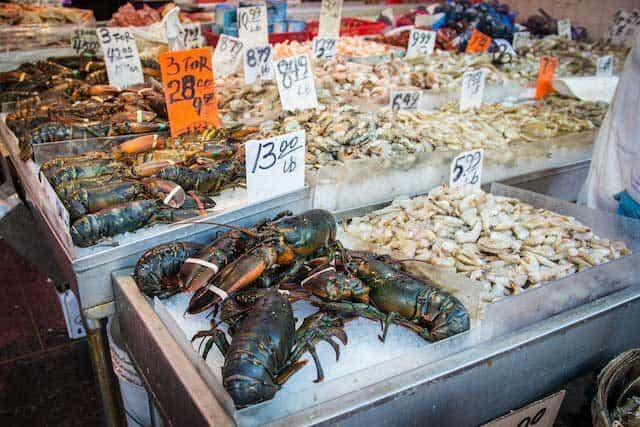According to a recent study, the global per capita fish consumption was 20.3 kilograms annually. This is an increase of about 17% from 2000 when the apparent per capita fish consumption was 17.4 kilograms annually. Thus, it’s a clear indication that more people love seafood delicacies. Besides, as the old adage goes, “it’s okay to eat fish because they don’t have feelings!”
However, finding quality, fresh seafood, if you don’t live near the ocean, can be a culinary challenge. Most standard fish stores have a limited selection of fresh seafood. And even devoted seafood lovers can’t eat out whenever a craving strikes.
But, thanks to modern technology, you can now buy fresh seafood online. So, regardless of location, you can still enjoy the best fresh seafood. With just a few clicks, seafood can be on its way to your doorstep!
So, how do you check for the quality of seafood when buying online? You can look for several important things to ensure you get high-quality seafood online. Read on!
Things to Look for When Buying Seafood Online to Ensure Quality
- Freshness
Freshness is a leading factor in determining the quality of seafood. Fresh seafood should have a clean, mild scent and firm flesh. As seafood ages, it can break down and develop a strong, fishy smell. This process can also cause the flesh to become soft or slimy. These are signs that the seafood is no longer fresh and is not of high quality.
Fresh seafood is also more flavorful and tender. But, as it stays longer, the flavor and texture can diminish and become less appealing. For these reasons, it’s essential to select fresh seafood carefully to ensure you get the best quality and taste.
Here’s how to choose fresh seafood:
- Look at the eyes: The eyes of fresh fish should be clear and not cloudy.
- Check the gills: The gills of fresh fish should appear reddish or pinkish, not brown or gray.
- Press the flesh: The flesh of fresh fish should be firm and bounce back when pressed, not mushy or indented.
- Smell the seafood: Fresh seafood should have a clean, mild scent. It is likely, not fresh if it has a strong, fishy smell.
But when you buy fresh seafood online from a reliable store, you can rest assured that you’re getting a high-quality, safe, and sustainably produced product. A reliable fresh seafood store is more likely to source marine delicacies from reputable suppliers. Better still, it handles and stores fresh seafood properly to preserve its freshness and flavor.
- Source

The source of fresh seafood also plays a significant role in determining its quality. Responsibly caught or farmed seafood is more likely to be of high quality.
Usually, fresh seafood caught in the wild varies in quality depending on the methods used to catch it. For example, bottom trawling is highly harmful to the environment as it destroys the natural sea floor. As a result, it catches non-target species, affecting the seafood’s overall quality.
Farmed seafood can also vary in quality. Some types of seafood, like shellfish, have a minimal environmental impact since it’s possible to farm them sustainably. However, some fish species are farmed in crowded, unsanitary conditions. This leads to lower-quality seafood.
Thus, when ordering fresh seafood online, you should consider the source as it determines the quality. Look for information about the catching and farming of seafood. It would also be best to choose sustainably sourced fresh seafood using responsible methods.
- Processing
Processing fresh seafood can also affect its quality. First, handling seafood properly is essential to preserving its freshness and flavor.
Careful handling of seafood helps to prevent bruising and damage to the flesh. It would help if you stored fresh seafood at the proper temperature to inhibit the growth of bacteria and other pathogens. If fresh seafood is not handled or stored correctly, it spoils quickly and becomes unsafe to eat.
In addition to handling, the way seafood is processed also impacts the quality. For example, if you freeze seafood immediately after catching it, you can preserve its freshness and flavor. But if you freeze it, then thaw and refreeze it multiple times, it can become dry and lose flavor.
Thus, it would be helpful to look for adequate information about the handling and packaging when you buy fresh seafood online. Choose products that have been handled and processed in a way that maintains freshness and flavor.
- Certification
Seafood certification programs are a helpful way to determine the quality of seafood. These programs set and ensure the meeting of standards in fishing for seafood.
Some certification programs focus on environmental sustainability. This ensures that farming and catching fresh seafood are done in a way that minimizes harm to the marine environment. Other programs focus on social responsibility. It helps to ensure that seafood is caught or farmed in a fair way for workers and communities.
By choosing certified seafood from one of these programs, you can rest assured that you will get the best fresh seafood that meets quality standards. Also, not all certification programs are equal, as some may have stricter regulations. So, when looking for reputable certification programs, research which ones have the most rigorous standards.
- Reviews
Reviews from other customers can help you determine the quality of seafood from a specific supplier. According to reliable statistics, about 79% of consumers focus more on online reviews. By reading reviews, you can see what other customers thought of the freshness, flavor, and overall quality of the seafood they bought.
However, keep in mind that reviews are not always reliable. Some can be subjective and may not accurately reflect the experience of all customers. So, it’s helpful to read several positive and negative reviews to understand the quality of fresh seafood.
Additionally, it’s vital to consider the credibility of the review source. Reviews on a supplier’s or third-party website may be less reliable. But reviews from a trusted source, like a famous food critic or a reputable consumer organization, are very compelling.
While reviews can help determine the quality of seafood, they should not be the only factor to prioritize. It’s also important to consider more factors to ensure you get quality, fresh seafood.
- Price

Be aware: the price of seafood is not a sure indicator of its quality. That being said, you get what you pay for regarding fresh seafood.
Sometimes, high-quality seafood can be expensive, while in other cases, lower-quality seafood can be cheaper. It usually takes more work to catch or farm high-quality seafood. Or, the processing may comprise methods that preserve freshness and flavor.
Conversely, lower-quality seafood may be cheaper because it was caught or farmed using less sustainable or responsible methods. Or, perhaps the handling was done in a way that resulted in a lower-quality product.
Most importantly, you should be wary of prices that seem too good to be true. If you see prices that are significantly lower than your expectations for a particular type of seafood, that’s likely a red flag. Nonetheless, it’s always a good idea to be willing to pay a little extra for quality, fresh seafood.
Bottom Line
There are plenty of reasons to buy fresh seafood online. From a wide selection to convenience, nothing beats having fresh seafood delivered to your doorstep.
However, as a lover of fresh seafood delicacies, I know that the quality of the meal depends on the quality of the seafood, irrespective of the recipe. Thus, purchasing quality fresh seafood is extremely important for your health.
Hence, always endeavor to buy fresh seafood online from a high-quality dealer. Fortunately, we’ve revealed what to look for in terms of quality when purchasing seafood online.










